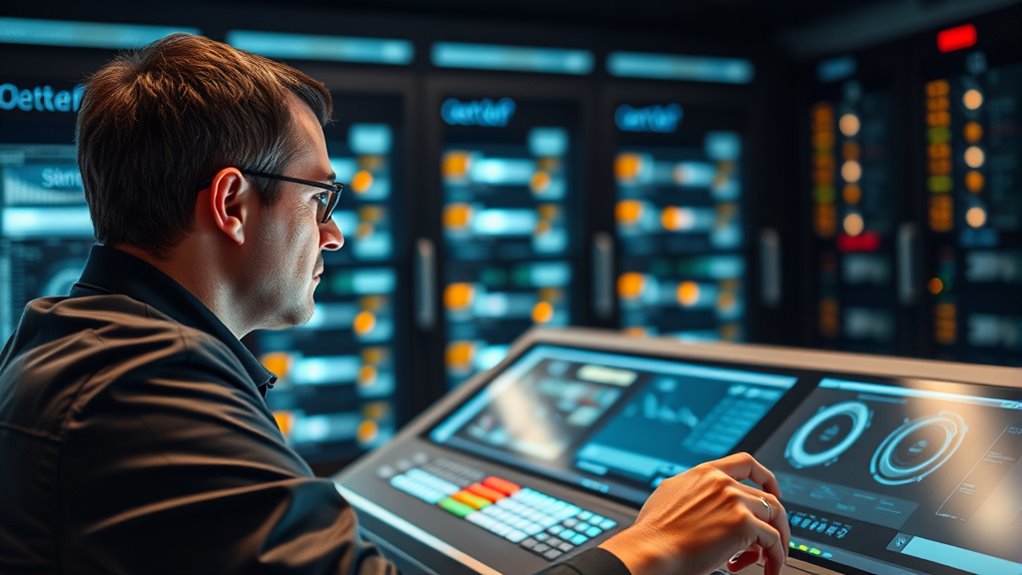In critical areas like healthcare and transportation, you must stay in control of AI systems to guarantee ethical decisions, verify outputs, and intervene during unexpected situations. Your oversight helps catch errors, biases, and failures that AI might miss, especially with complex or nuanced circumstances. By remaining involved, you help promote safety, fairness, and accountability. If you want to understand exactly where and how your control is essential, keep exploring these essential roles further.
Key Takeaways
- In high-stakes decisions such as healthcare diagnoses and autonomous vehicle navigation, humans must oversee and verify AI outputs.
- Human judgment and ethical considerations are essential in sensitive areas where nuanced understanding is critical.
- Humans should intervene during unpredictable or unforeseen situations to prevent accidents or errors.
- Final approval of AI-generated recommendations, especially in critical fields, ensures accountability and safety.
- Workflows should be designed to keep humans actively engaged and responsible for overseeing AI decisions.

Have you ever wondered how humans and artificial intelligence work together to solve complex problems? It’s a partnership that’s becoming more common as AI systems grow smarter and more autonomous. But with this increasing reliance on machines, a key question emerges: where must people stay in control? The concept of “human-in-the-loop” centers on guaranteeing that humans remain involved in critical decisions, especially when stakes are high or outcomes uncertain. You need to understand that AI can handle vast data analysis, pattern recognition, and rapid decision-making. However, there are situations where human judgment, ethics, and intuition are irreplaceable.
In fields like healthcare, for example, AI can assist in diagnosing diseases by analyzing medical images faster than humans. But the final diagnosis often depends on a doctor’s expertise, considering patient history, subtle symptoms, and ethical implications. Here, the human must stay in control, verifying AI suggestions and making nuanced decisions. Similarly, in autonomous transportation, self-driving cars can detect obstacles and navigate traffic efficiently. Yet, a human driver or supervisor should be prepared to intervene if the AI encounters a situation it can’t handle—like unexpected roadblocks or unpredictable pedestrian behavior. The goal is to make sure that humans are always ready to step in during unforeseen circumstances, preventing accidents or errors.
You also have to contemplate that AI systems are not infallible. They can be biased, make mistakes, or misinterpret data. That’s why keeping humans in the loop becomes a safeguard—an oversight layer that catches errors the machine might overlook. It’s about balancing automation’s efficiency with human oversight to ensure fairness, accountability, and safety. In military or security contexts, human oversight becomes even more critical. Fully autonomous weapons or surveillance systems might be efficient, but ethical concerns and the risk of unintended consequences argue strongly for human control over lethal or sensitive decisions.
Ultimately, the key is designing AI systems that enhance human capabilities rather than replace them. You want to create workflows where humans remain engaged, making critical calls, especially when moral or contextual judgment is necessary. The human-in-the-loop approach doesn’t mean just watching from the sidelines; it’s about actively supervising, guiding, and intervening when needed. This ongoing partnership ensures AI remains a tool that amplifies human intelligence without undermining control or accountability. Considering the importance of color accuracy and other technical factors, it’s clear that human oversight is essential for maintaining optimal performance. In complex, high-stakes environments, your role as a human operator is essential to maintaining responsibility and ensuring outcomes align with ethical standards and societal values.
Frequently Asked Questions
How Do Human-In-The-Loop Systems Impact AI Transparency?
Human-in-the-loop systems enhance AI transparency by ensuring people oversee decision-making processes. You stay in control by actively monitoring outputs, providing feedback, and adjusting algorithms as needed. This involvement makes AI actions more understandable and accountable, helping you identify biases or errors. Your engagement bridges the gap between complex AI operations and user comprehension, fostering trust and clarity while maintaining essential human oversight throughout AI’s functioning.
What Industries Benefit Most From Human Oversight?
You benefit most from human oversight in healthcare, finance, and autonomous vehicles. These industries demand diligent decision-making, detailed data, and delicate judgment calls that AI alone can’t handle. By maintaining human control, you guarantee accuracy, accountability, and ethical oversight. Human involvement prevents pitfalls, promotes trust, and perfects performance, proving that people’s perceptive prowess is irreplaceable in these high-stakes sectors where precision and prudence matter most.
How Is Human Bias Minimized in Decision-Making?
You can minimize human bias in decision-making by implementing diverse teams, providing bias-awareness training, and using data-driven algorithms. Regularly review and audit decisions to identify and correct biases. Encourage transparency and accountability, and incorporate multiple perspectives to balance subjective views. By actively questioning assumptions and continuously refining processes, you reduce the influence of personal biases and foster fairer, more objective outcomes.
What Are the Ethical Implications of Automation?
Automation offers amazing efficiency but also raises serious ethical concerns. You must consider issues like accountability, as machines make more decisions without human oversight, leading to potential biases or errors. Privacy privacy, and fairness become pressing priorities, demanding proactive policies and transparent processes. You should stay vigilant, ensuring that automation aligns with moral values, respects human rights, and maintains trust, preventing the pitfalls of unchecked technological power.
How Do Regulations Govern Human-In-The-Loop Applications?
Regulations govern human-in-the-loop applications by setting clear standards for oversight, accountability, and safety. You’re required to guarantee humans remain involved in critical decision points, especially where ethical or safety concerns exist. Authorities enforce compliance through audits, reporting, and certifications. You must stay updated on evolving laws to avoid penalties and ensure your systems prioritize human judgment, safeguarding public interests and maintaining trust in automated processes.
Conclusion
As you consider where humans should stay in control, remember that technology is a tool to serve you, not replace your judgment. You must decide the balance where automation enhances your decision-making without stripping away your agency. Isn’t it your responsibility to guarantee that, even in a high-tech world, your values and ethics remain at the core? Ultimately, human-in-the-loop design challenges you to stay engaged and vigilant—are you prepared to take that responsibility seriously?









